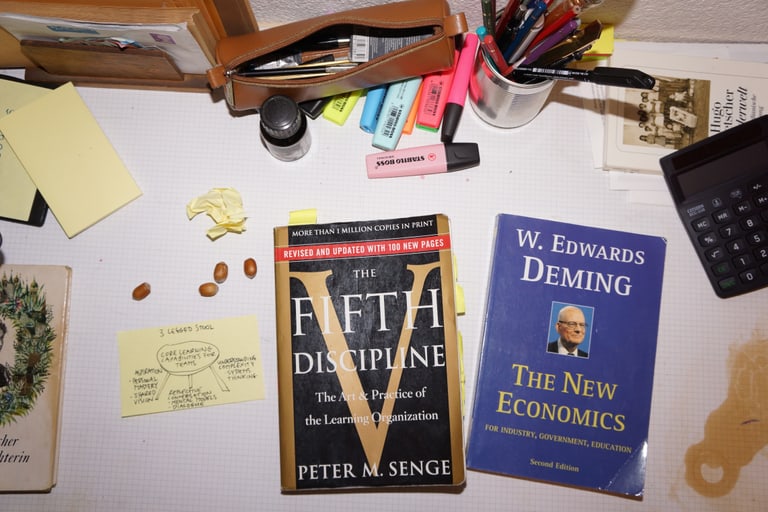Systems Thinking
The value of an organization that is capable of learning and adapting to new challenges from within now appears broadly recognised. Yet, in terms of the actual implementation of a learning culture within the organization most of us are still a long way off. The "Art and Practice" of the Learning Organization is an inspirational toolkit brought forward by Peter M. Senge in 1990, drawing on inspiration from W. Edwards Deming's work on quality management in the US and Japan. Senge identified the ability to apply Systems Thinking throughout an organization as a key factor for successful businesses.
Senges concept interweaves personal learning and development with a holistic understanding of the organization we work in, dismissing old and prevailing ideas of management by objectives and rewards. These are ideas we sadly still struggle with today. As Deming before him, Senge identified a shared purpose as a key motivator for employees to continuously invest in learning for the benefit of themselves and the organization. As the name "Learning Organization" implies, education is at the heart of the idea. The Learning Organization is built around the belief that better understanding of the context we are in coupled with continuous learning will make for better business.
The challenges of the VUCA world
Thirty years later these beliefs seem even more relevant, particularely for organizations with high exposure to the challenges of the VUCA world; a world that is volatile, uncertain, complex and ambiguous. Organizations in the VUCA world work in areas where it is extremely hard to predict what lies ahead in a few years time. These are mainly organizations facing a high likelihood of digital disruption to their business.
Learning in the Flow of Work
While the concepts of Deming and Senge from the late 80s and early 90s are still gaining traction today, the discourse around learning and development is currently centered more around the term "learning in the flow of work" coined by Josh Bersin, who regularly refers to "the Learning Organization". Bersin's idea is about embedding time and tools for learning into our day to day work, rather than offering isolated courses and trainings, while putting the emphasis on peer education and a general learning culture. It is indeed an enticing prospect not having to access yet another tool to learn, but rather to have the learning tools embedded in the tools I have to use for my day to day work anyway, such as; chat, mail, calendar and wiki. This approach is basically Microsoft's sales pitch for their Teams and Office 365 suite.
I believe in this vision, but wonder what it does with things like "flow" if our work is split into even more periods of "microfocus" and yet more context switching with blurred boundaries.
Maturity of the Learning Organization
As our own organization deals with digital progress, we are keen to explore new ideas that address the need for learning "in the flow" in the digital workplace. Our idea of learning includes a diverse range of topics such as skill matching, learner - tutor matchmaking or personal interests. We want to explore where Machine Learning, Predictive Analytics and an intelligent Enterprise Search can help us learn more, while empowering people rather than patronizing them. But more on that later. For now, we need no machine to inspect our own organization. Let's just take a step back and think about where we stand in terms of maturity. In their industry study [1] from 2017 Bersin/Deloitte published an interesting definition of maturity levels for organizations. It helps us think about where we stand with our own organization and where we would like to see ourselves in the future. Where would you place your organization?
The Learning Organization Maturity Model
By Bersin/Deloitte
Level 1: Episodic / Programmatic
- Effects change through courses / programs
- Relies on a top-down approach to development
- Drives development of selected knowledge & skills
- Focuses on enabling performance in current role
Level 2: Responsive / Contextualized
- Effects change through creating employee-centric learning
- Applies design thinking to employee-development initiatives
- Focuses on implementing transparent systems & processes that personalize development
Level 3: Continuous / Empowering
- Effects change through empowering individual-driven development
- Leverages experiences & consistent feedback for development
- Continuously evolves technology infrastructure
- Focuses on creating conditions that enable development
Level 4: Anticipatory / Flow
- Effects change by anticipating deeds and then augmenting & leveraging the developmental opportunities intrinsic in work
- Concentrates on long-term career success & creating enduring commitment to development
- Fosters a culture of courage & innovation
- Integrates feedback loops & data into work design
- Focuses on supporting employees’ ability to evolve & adapt
1: High-Impact Learning - Organization Maturity Model and Top Findings, by Bersin by Deloitte, 2017

